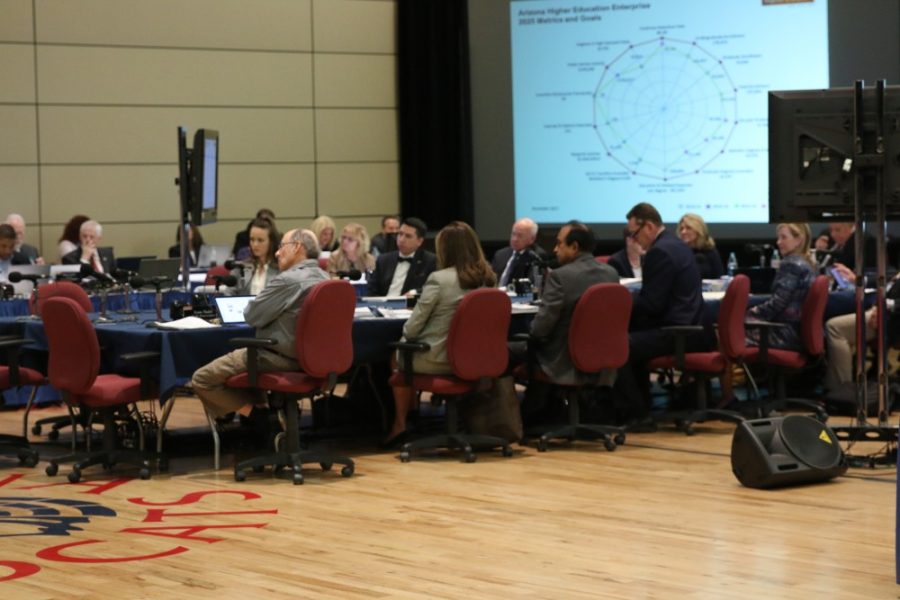Where do you stack up against other students in terms of debt, financial aid and how much money people with your degree make? Data on financial aid, enrollment and graduate wages was released and discussed during the Arizona Board of Regents meetings at the University of Arizona on Thursday, Nov. 15 and Friday, Nov. 16.
Financial Aid
To combat admission costs, $732.6 million was given to UA students to help pay for school. This money came from loans, private scholarships, employment, the state, FAFSA and the UA itself.
However, in 2018, the average undergraduate and graduate student still walked away from the UA $24,968 and $67,534 in debt, respectively. Furthermore, 17,571 students received federal loans, and undergraduate and graduate debt amounts increased by 12.1 percent and 19.6 percent, respectively.
RELATED: Arizona Board of Regents fall 2018: Day one recap
The board stated these numbers were unacceptable, especially when considering the Arizona Constitution states the public universities must be as “nearly free as possible.”
“The debt for tuition for in-state students and the overall tuition costs for in-state students has been operating under, from our perspective, as prime directive number one, to keep those costs as low as possible, to keep that debt as low as possible,” Arizona State University President Michael Crow said.
The board is now considering an alternate method to make schools at least debt-free for students, if not completely free.
“It may be time to consider an alternative model of helping students finance their education,” Regent Jay Heiler said. “It’s interesting that we hear out in the political conversation … a call for a free college education, which, in my view, is not a particularly constructive proposal. But it would be highly constructive to do whatever we can to advance to a debt-free college education, which is materially different than a free college education. We can advance towards that over a long period of time and make significant gains along the way in reducing debt, thereby increasing access.”
They said they hope to put a plan into motion by 2020.
Enrollment
A goal for the education leaders in Arizona is to get 60 percent of Arizonans 25 and older to have a certificate or college degree by 2030. The goal, called Achieve60AZ, was prompted by statistics that showed only 18 percent of Arizonans had this level of education.
The state schools measure their enrollment data based on these quota goals. According to the enrollment report released by the regents, the UA’s “total headcount enrollment increased but continues to miss enterprise plan goals.”
The UA enrolled 44,526 total students in 2018, a very slight increase from 44,216 the year before and 42,236 in 2014.
At the UA Tucson campus, total head count has “steadily declined,” going from a four percent enrollment growth in 2014 to just a 0.8 percent increase in 2018. UA South was hit harder, with a loss of 8.1 percent in 2018. In 2015, it lost 52.2 percent of its total student population.
Also, approximately 10 percent of UA’s students are enrolled online.
Compared to the other state schools, the UA is in the middle. Northern Arizona University’s total head count enrollment “declined and missed ABOR strategic plan goals,” while ASU’s headcount enrollment growth “exceeds enterprise plan goals at every level,” according to the report.
Graduate Wages
Wages for students get better with time, according to data from the Wages of Graduates report. For UA undergraduate resident students, one year after graduation students were making an average of $30,585 in 2017. Five years after graduation, students made $46,640 on average in 2017, and ten years after graduation, they made $63,331. For non-resident students, the one-, five- and ten-year numbers were $33,557, $54,466, and $76,557, respectively.
For those still living in Arizona, UA graduates earned $4.7 billion in wages in 2017.
RELATED: Regents vote to change tuition-and-fee setting process
The report also detailed the median wages for each field from 2013-2017, showing how many students graduated from each major field. While the largest number of undergraduate students graduate with a business degree, they make around $14,000 less than the highest-making degrees.
The highest median wages for undergraduate degrees, according to the report, came from the computing and engineering fields, with graduates making $52,715 and $54,952, respectively.
The same instance happened with the graduate students. The largest number of graduate students graduate from the UA School of Medicine and go into health professions and related clinical sciences professions. The median wage for that group was $53,990.
For graduates, the highest median wages came from the engineering, business and computing fields. The median wages for these were $73,293, $73,278 and $70,902, respectively.
The lowest-paying professions for undergrads were legal professions and studies degrees, who made a median of $12,447. For graduate students, the lowest paying field was in visual and performing arts, with a median of $14,132.
Follow Rocky Baier on Twitter









